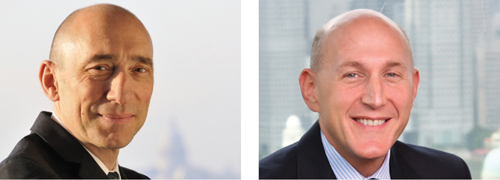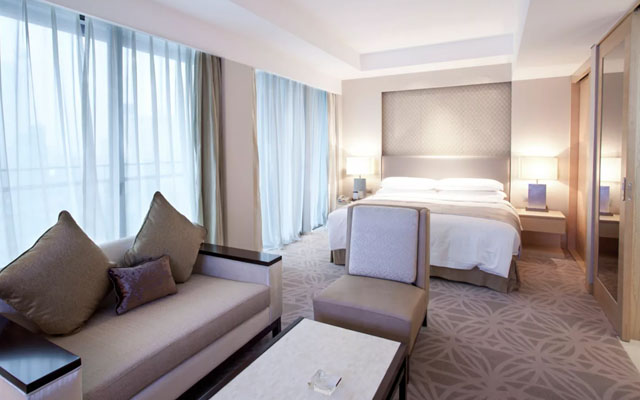Chain is growing fatter all the time but its chiefs tell Raini Hamdi it can digest what it chews

From left: Denis Hennequin, Chairman & CEO, Accor; Michael Issenberg, Chairman & COO, Accor Asia-Pacific
Accor marked 30 years of Asia-Pacific presence last November with a bumper crop of hotels signed in the region. By 2015, it will have 700 hotels in operation in Asia-Pacific, from 550 hotels now, which is already a huge figure. Competitors such as Starwood Hotels & Resorts and Marriott International are smaller: respectively, 320 hotels in Asia by 2014 (as of September 20, 2012) and at least 265 hotels by 2016 (as of October 31, 2012).
Some people say your first priority is to earn fees, increase shareholder value, which these numbers do perpetuate. What say you?
DH: It is not chasing numbers for the financial community but to answer to increased demand as a result of the booming economy here and in other parts of the world. We have a pipeline of 110,000 rooms within the next three years; 50 per cent is in Asia-Pacific because it is the vibrant part of the world today. Basically, supply is following demand.
How do you measure how successfully you’ve done for owners?
DH: The appetite owners show for our brands is the best measure. For them, it is a game of ROI. If they are not satisfied with what we bring to the party as operator, our pipeline will just vanish. To the contrary it is accelerating.
MI: We’re not in the business of running unsuccessful hotels. When you get it wrong (with a hotel), the amount of energy and the time it consumes to try and turn it around is distracting. So we really try and focus on success in terms of the right hotel with the right partner in the right location. More often than not, we do feasibility studies with the owners to make sure their project will be a success. We try and educate the owners when to expect success, as hotels take anywhere between three and five years to hit maturation.
What are the extra demands of running a public company?
DH: Public companies have more resources, as they are appealing to the financial markets. That’s a benefit, of course, but with greater benefits come greater challenges and responsibilities, so it’s about finding the balance (to satisfy) all the stakeholders – our people, owners, shareholders, etc – that’s my job.
What changes did you make since becoming CEO in January 2011 that did real good for Accor?
DH: We’ve been focusing on three strategies: brands, distribution and development.
We’ve been revisiting the strength of all our brands and segments, to make them even more efficient and a step ahead. We started with Ibis, but if you look at the whole portfolio, we’ve been doing the same exercise with all our brands, whether it is repositioning Sofitel, Pullman, MGallery, etc. There’s not one brand we’re ignoring in terms of finding out what its DNA is and how we can move it forward and lead the market segments.
In terms of distribution, today, having a good hotel, brand, location and people running it is not enough; you have to know how to sell the hotel to your guests, so we have been revisiting our distribution model and loyalty programmes. And finally, development. We were born in Europe and obviously most of our inventory is in Europe where we’re by far market leader. But we see that the world has become a village and we have to increase our presence outside Europe.We’re now leader in Asia-Pacific, Latin America, Africa and the Middle East – everywhere except North America.
“When we acquire companies we also acquire talent…When we bought Mirvac, we also got 3,000 people and there will be some great talent that we will mine.”
Are you confident of opening another 100 hotels this year, after last year’s bumper of 110 hotels, or will growth taper?
MI: In 2011, we opened about 65 hotels. Last year, with the Mirvac acquisition, it exceeded; without, it would be 68-70. Looking at our pipeline in the next three years, I expect to maintain that growth of opening 60-70 hotels.
How are you able to open 60-70 hotels a year without operation fraying around the edges, especially when there’s a staff crunch?
MI: As a hotel management company, we’re really two things: we’re a sales and marketing organisation and a human resource company. So the challenges are to make sure we have the right tools to fill the hotels and to have the human capability, which is the single biggest challenge, but in some respects the most rewarding, as we’re building tremendous careers for young people.
But that’s what we do. If you look back at our development in the last 30 years, from 13 hotels in 1990 to 550 last year, we’ve developed the systems, capability and the people to do large-scale growth. There was only one (Accor) academy for Asia-Pacific, then one Pacific, one Asia. Now, we have academies in China, Thailand, Indonesia and India.
When we acquire companies, we also acquire talent. Our CFO and CMO came from a company we acquired in 1993. When we bought Mirvac, we also got 3,000 people and there will be some great talent that we will mine.
DH: This also results in a cultural change for Accor. We’ve become truly international, from a French model, so to speak. When I’m here or in Latin America, Africa, Middle East, I find lots of new ideas and concepts that I can feedback into the original model, which is European. We’re benefiting from that cross exchange of culture and talent from all parts of the world. That’s the true competitive advantage of being international, to feed yourself with all the talent and different points of view. Successful global companies are the ones that understand new models better before anyone else does. There’s not one dominant model; that’s over. Actually it’s a collage.
MI: A good example was we had 300 French franchisees – owners of Novotel, Mercure, etc – meeting in Bangkok recently. They chose Asia themselves; they wanted to see how more hotels are being built here, the latest trends, etc.
What will you be investing on in order to support 700 hotels in the region by 2015?
DH: Brand, distribution, development.
What are the key changes in Asia that you’ll be looking out for?.
MI: The biggest change is that our business is increasingly inter-Asia. China is the biggest driver, changing from an export- to a consumer-driven economy. Going back to some of your questions earlier about us grabbing shelf space, the fact is what’s happening in Asia is extraordinary. Even if China slows to seven to eight per cent, travel still continues to grow at 12-14 per cent. Then look at Indonesia, Malaysia, India, the Philippines and Myanmar opening up. We’ve dealt with financial crises and tragedies and those will continue. But we believe in the Asian century and that it’s here for the next 10 years.
This article was first published in TTG Asia, January 11 issue, on page 4. To read more, please view our digital edition or click here to subscribe.




















